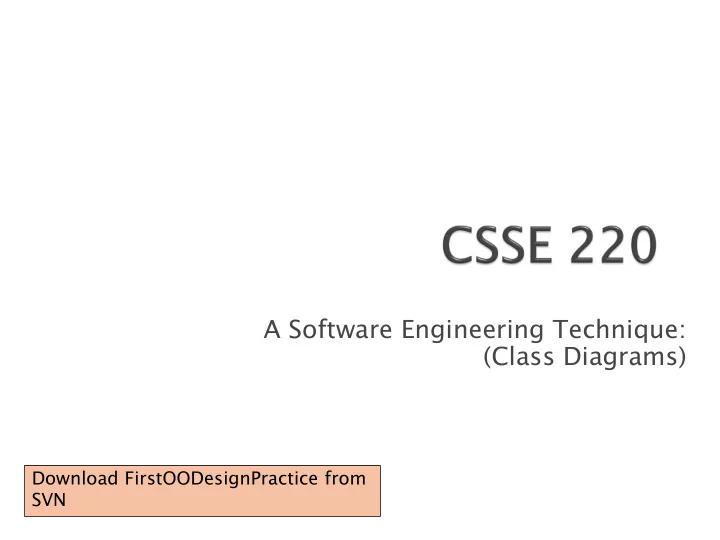

A Software Engineering Technique: (Class Diagrams) Download FirstOODesignPractice from SVN
Part 1 of Many Also Class Diagrams
• Programs typically begin as abstract ideas • These ideas form a set of requirements (i.e. what the user wants) • We must take these requirements, and figure out an approach for our coding • Usually the approach is not obvious • So we propose designs, then iteratively refine them into something that might work (continued…)
• So we propose designs, then iteratively refine them into something that might work • Many bad ideas in the process • We don’t want to go through the effort of implementing bad ideas in code • But we need a way to communicate/think concretely about these half-baked program approaches • We need a diagram language!
Class Diagrams (UML) UML – Unified Modeling Language ◦ Language unspecific ◦ Has a lot of different diagrams it provides specifications for – but the class diagram language is the most widely used
3 sections • ClassName Not the final version of • Field names UML we will teach, but covers the main points Method names Example le Team Student teamAverage grades name name students addGrade(grade) addGrade(grade) getTeamAverage()
A has a B (field) ClassName ClassName Field names Field names Method names Method names Example le Note the star means several… usually a list or collection. Team Student teamAverage * grades name name students addGrade(grade) addGrade(grade) getTeamAverage()
Interface Association Inheritance Dependency Implementation (is-a) (has-a-field) (depends-on) (is-a) Two-way Association Two-Way Dependency Cardinality (one-to-one, one-to-many) One-to-many is shown on left
We want to have a system that lets us search the catalogs of various nearby libraries for books. We need to track the names, phone numbers, and addresses of the libraries. We need to track the titles, authors, and ISBN numbers of the books. The main operation of the system is to search for a particular book by keyword (could be author, title, or ISBN), and get a listing of its info and the library that has it. In a g group up of 2-3, co come me up with h a o object ct design gn for this s sys ystem tem and document cument it in UML ML (on a s sheet t of paper) r).
Book Library name name author address isbn phone matchesKeyword(word) * * Some notes: a. It’s not really necessary to list fields for books/libraries if LibraryMain you have lines b. Technically, we could books probably get away with just a libraries books list (though adding new booksForKeyword(word) books would be difficult in handleSearch(word) that case) main
LibraryMain Your design might have just included classes Book and Library – but booksForKeyword(word) remember all books and libraries must handleSearch(word) be stored somewhere main In really small programs, you could just have them as local variables in a static main But for larger programs, it’s more usual for the class with main to be a real class with fields (also aids testing) In our very simple designs, this class also deals with user input Also be sure your design shows where things start and how user commands are handled
The “things” of what you’re describing usually become the classes ◦ The verbs usually become methods of the classes Avoid using plurals ◦ We make an ArrayList of Face objects, not Faces. Make it work! ◦ Go through it with some “use case” in mind and make sure that when this object is created, you can accomplish that case. Otherwise, redesign that design until it “works!!!”
Come from nouns in the problem description May… ◦ Represent single concepts Circle , Investment ◦ Represent visual elements of the project FacesComponent , UpdateButton ◦ Be abstractions of real-life entities BankAccount , TicTacToeBoard
A factory sells a small number of unique products. Each product has an id code, a description, price and quantity (the amount currently available at the factory). When a customer places an order, they buy a specific number of each product. The order needs to be stored in the system for future reference, with the customer’s name and address . At some point, the order should ship to the customer, and that date should also be recorded. The main operation of the system is to add a new order and mark an order as shipped. In a g group up of 2-3, make ke with an object ct design gn for this s sys ystem tem an and docum cument ent it in UML ML (on pap aper er).
Now orders can be partially shipped – i.e. a single order might take several shipments to complete. The main operation of the system is to add a new order and enter shipments for orders. In a g gro roup of 2-3, 3, re revise ise your r desig sign n to accommo moda date te this is new is issue. ue.
Product Order id name description address price * phone factoryQuantity ProductOrder * quantity * * * Shipment date FactoryMain creating order ?? creating shipment ?? main
Decide what classes ought to be in the system and what methods/fields those classes should have (your design should have at least 2 classes) Don’t forget one class needs to have a main method Make sure your design works! Write down your answers on a piece of paper with all of your team’s names on it – this will be your quiz for today Call me over when you think you’re done – then you’ll implement it
Decide what classes ought to be in the system and what methods/fields those classes should have (your design should have at least 3 classes) Don’t forget one class needs to have a main method Make sure your design works! Write down your answers on a piece of paper with all of your team’s names on it Call me over when you think you’re done
Recommend
More recommend